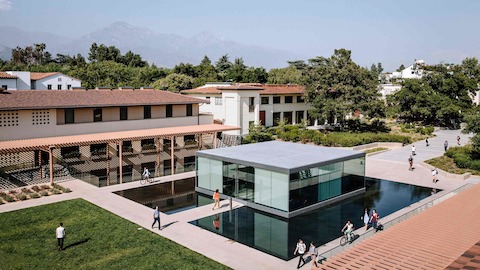Claremont McKenna College
Colleges are realizing that, with the right characteristics, place can help students and faculty feel connected and build a sense of community.
Claremont, California, US
Download PDF (1.1 MB)
Through our work with colleges like Claremont McKenna, we’ve learned that students and faculty who have a strong sense of belonging are more engaged, productive, and feel less stress. That sense of community reduces the chances that students will transfer or drop out.
We’ve also learned that the best way to build a sense of community on campus is to offer students and faculty a variety of spaces where they can easily connect. Claremont McKenna’s Kravis Center, designed by world-renowned architect Rafael Viñoly, is a good example. From alcoves for small group discussions to traditional classrooms and private offices, students and faculty have a choice of supportive spaces where they can work together.
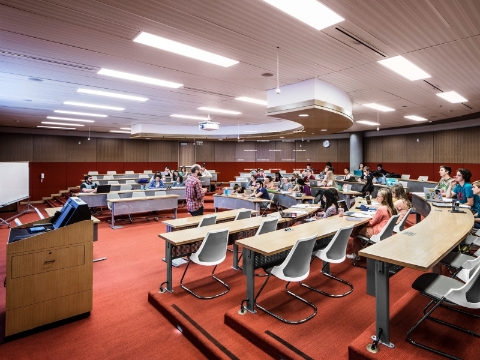
In this auditorium, ceiling microphones transmit students’ questions, helping everyone feel connected and engaged, regardless of where they sit.
Students and teachers alike are drawn to alcoves that are scattered throughout the building, attracted by their casual feel and natural light. Sometimes the meetings that take place in these spaces are planned. Other times, students and faculty members will bump into each other in the hallway and have a quick chat. When these chats turn into conversations, people can move to an alcove, where there are fewer distractions.
While informal meeting spaces are popular in the Kravis Center, traditional classrooms and auditoriums still serve an important purpose: they allow professors to engage with a large number of students at the same time. In the past, these vast spaces with tables and chairs in stationary rows have made dynamic teaching and learning difficult. At Kravis, the furnishings are mobile, so they can be easily rearranged as a class progresses.
Says Lars Schmitz, biology professor, of the adaptive furnishings. “You can be more flexible in how you design your hour. Maybe you start with a lecture, then break into small groups, and conclude with classroom-wide discussion.” With furniture and tools that move, it’s possible to make the space fit the activities of the students or the teaching style of the faculty members using the space.
Flexibility doesn’t matter, however, if students can’t hear the material as it’s being discussed. Schmitz leads an introduction to biology course in a Kravis Center auditorium, where ceiling microphones transmit what students and faculty are saying. The excellent acoustics help everyone feel connected and engaged in the learning experience. The learning venue itself can also send a message about the professor’s view of and expectations for the students.
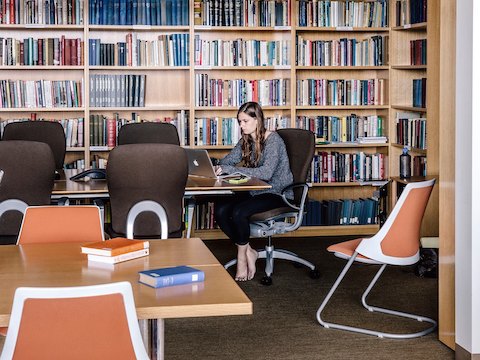
Claremont McKenna offers students and faculty a choice of supportive spaces where they can study or work.
Piotr Florcyzk, a visiting lecturer in Claremont McKenna’s Literature Department, teaches in a boardroom rather than a traditional classroom. He believes that meeting in the same tastefully appointed space that the school’s board meets “shows the students that their voices and opinions matter, and that they are co-creators of the learning environment.” Furthermore, students are more likely to share their thoughts when everyone is sitting around a table, he says.
Alcoves, classrooms, auditoriums, and boardrooms can all support connection. But occasionally what professors need most is a retreat to read, think, and recharge so that when they do meet with students again, they can be at their best. And there are times that professors need a place for confidential conversations. The faculty office is still valued for the respite and privacy it provides.
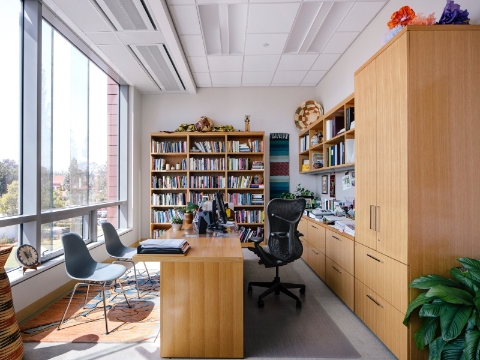
Spacious, sunlit offices with furnishings that enable collaboration promote the close student-professor relationships that Claremont McKenna is known for.
Claremont McKenna’s faculty offices feature natural light and views of nature, which help professors take a breath, relax, and connect with themselves, as well as others.
When faculty and students have what they need, and when learning spaces support connection, a university has all the elements necessary for creating a community on campus. Max Benavidez, associate vice president for public affairs and communications, says that, while the entire campus reflects and encourages this, the Kravis Center is perhaps the college’s penultimate example: “It’s warm, inviting, current, and modern and demonstrates that everyone here is open to dialogue and interaction.”
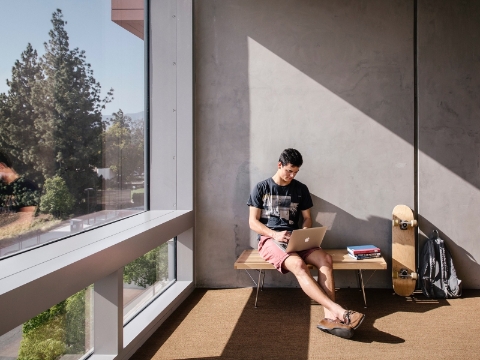
Students are drawn to alcoves and benches scattered throughout the building and grounds for their casual feel and natural light.
